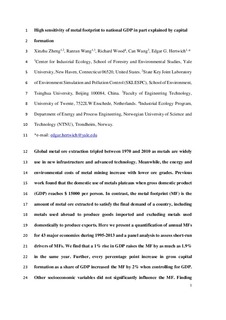High sensitivity of metal footprint to national GDP in part explained by capital formation
Journal article, Peer reviewed
Accepted version
Permanent lenke
http://hdl.handle.net/11250/2594392Utgivelsesdato
2018Metadata
Vis full innførselSamlinger
Sammendrag
Global metal ore extraction tripled between 1970 and 2010 as metals are widely used in new infrastructure and advanced technology. Meanwhile, the energy and environmental costs of metal mining increase as lower ore grades are being exploited. The domestic use of metals has been found to reach a plateau when gross domestic product reaches US$15,000 per person. Here we present a quantification of the annual metal footprint (that is, the amount of metal ore extracted to satisfy the final demand of a country, including metals used abroad to produce goods that are then imported, and excluding metals used domestically to produce exports) for 43 large economies during 1995–2013. We use a panel analysis to assess short-term drivers of changes in metal footprint, and find that a 1% rise in gross domestic product raises the metal footprint by as much as 1.9% in the same year. Further, every percentage point increase in gross capital formation as a share of gross domestic product increased the metal footprint by 2% when controlling for gross domestic product. Other socioeconomic variables did not significantly influence the metal footprint. Finding ways to break the strong coupling of economic development and investment with metal ore extraction may be required to ensure resource access and a low-carbon future.
